(All information courtesy of the instrument teams.)
![]() Previous IAU Circulars
Previous IAU Circulars
TITLE: GCN/SWIFT NOTICE
NOTICE_DATE: Tue 06 Mar 07 16:42:31 UT
NOTICE_TYPE: Swift-BAT GRB Position
TRIGGER_NUM: 263361, Seg_Num: 0
GRB_RA: 148.082d {+09h 52m 20s} (J2000),
148.178d {+09h 52m 43s} (current),
147.414d {+09h 49m 39s} (1950)
GRB_DEC: +10.471d {+10d 28' 17"} (J2000),
+10.437d {+10d 26' 15"} (current),
+10.707d {+10d 42' 24"} (1950)
GRB_ERROR: 3.00 [arcmin radius, statistical only]
GRB_INTEN: 44847 [cnts] Image_Peak=705 [image_cnts]
TRIGGER_DUR: 12.160 [sec]
TRIGGER_INDEX: 478 E_range: 25-100 keV
BKG_INTEN: 217776 [cnts]
BKG_TIME: 59990.19 SOD {16:39:50.19} UT
BKG_DUR: 64 [sec]
GRB_DATE: 14165 TJD; 65 DOY; 07/03/06
GRB_TIME: 60088.17 SOD {16:41:28.17} UT
GRB_PHI: 106.31 [deg]
GRB_THETA: 33.01 [deg]
SOLN_STATUS: 0x3
RATE_SIGNIF: 13.30 [sigma]
IMAGE_SIGNIF: 9.85 [sigma]
MERIT_PARAMS: +1 +0 +0 +4 +2 +0 +0 +0 +94 +1
SUN_POSTN: 346.86d {+23h 07m 27s} -5.63d {-05d 37' 39"}
SUN_DIST: 160.89 [deg] Sun_angle= -10.8 [hr] (East of Sun)
MOON_POSTN: 193.11d {+12h 52m 25s} -8.50d {-08d 29' 42"}
MOON_DIST: 48.56 [deg]
MOON_ILLUM: 93 [%]
GAL_COORDS: 225.67, 44.76 [deg] galactic lon,lat of the burst (or transient)
ECL_COORDS: 146.65, -2.30 [deg] ecliptic lon,lat of the burst (or transient)
COMMENTS: SWIFT-BAT GRB Coordinates.
COMMENTS: This is a rate trigger.
COMMENTS: A point_source was found.
COMMENTS: This does not match any source in the on-board catalog.
COMMENTS: This does not match any source in the ground catalog.
COMMENTS: This is a GRB.
COMMENTS: This trigger occurred at longitude,latitude = 130.73,7.48 [deg].
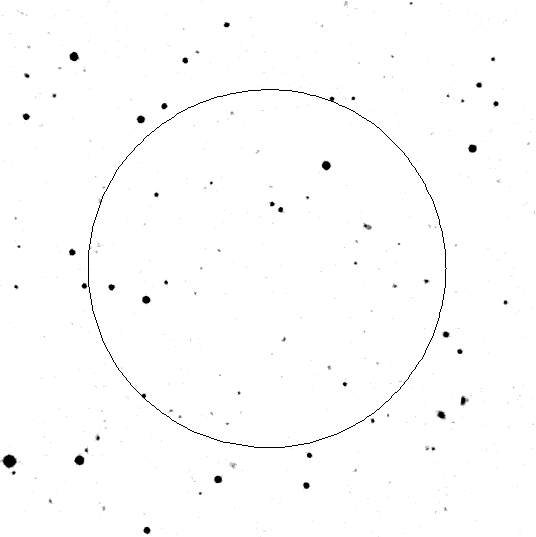
TITLE: GCN/SWIFT NOTICE
NOTICE_DATE: Tue 06 Mar 07 16:44:27 UT
NOTICE_TYPE: Swift-XRT Image
TRIGGER_NUM: 263361, Seg_Num: 0
GRB_RA: 148.0980d {+09h 52m 23.5s} (J2000),
148.1938d {+09h 52m 46.5s} (current),
147.4297d {+09h 49m 43.1s} (1950)
GRB_DEC: +10.4827d {+10d 28' 57.7"} (J2000),
+10.4488d {+10d 26' 55.5"} (current),
+10.7182d {+10d 43' 05.4"} (1950)
GRB_ERROR: 6.1 [arcsec, radius, statistical plus systematic]
GRB_INTEN: 24 [cnts]
IMG_START_DATE: 14165 TJD; 65 DOY; 07/03/06
IMG_START_TIME: 60241.37 SOD {16:44:01.37} UT, 153.2 [sec] since BAT Trigger Time
CENTROID_X: 391.24, raw= 391 [pixels]
CENTROID_Y: 300.99, raw= 301 [pixels]
ROLL: 283.11 [deg]
GAIN: 1
MODE: 2, Short Image mode
WAVEFORM: 134
EXPO_TIME: 0.10 [sec]
GRB_POS_XRT_Y: 7.05
GRB_POS_XRT_Z: 209.66
IMAGE_URL: sw00263361000msxps_rw.img
SUN_POSTN: 346.86d {+23h 07m 27s} -5.63d {-05d 37' 37"}
SUN_DIST: 160.90 [deg] Sun_angle= -10.8 [hr] (East of Sun)
MOON_POSTN: 193.12d {+12h 52m 29s} -8.50d {-08d 30' 08"}
MOON_DIST: 48.56 [deg]
MOON_ILLUM: 93 [%]
GAL_COORDS: 225.66, 44.78 [deg] galactic lon,lat of the burst
ECL_COORDS: 146.66, -2.28 [deg] ecliptic lon,lat of the burst
COMMENTS: SWIFT-XRT Image.

TITLE: GCN/SWIFT NOTICE
NOTICE_DATE: Tue 06 Mar 07 16:44:31 UT
NOTICE_TYPE: Swift-XRT Processed Image
TRIGGER_NUM: 263361, Seg_Num: 0
GRB_RA: 148.0980d {+09h 52m 23.5s} (J2000),
148.1938d {+09h 52m 46.5s} (current),
147.4297d {+09h 49m 43.1s} (1950)
GRB_DEC: +10.4827d {+10d 28' 57.7"} (J2000),
+10.4488d {+10d 26' 55.5"} (current),
+10.7182d {+10d 43' 05.4"} (1950)
GRB_ERROR: 6.1 [arcsec, radius, statistical plus systematic]
GRB_INTEN: 24 [cnts]
IMG_START_DATE: 14165 TJD; 65 DOY; 07/03/06
IMG_START_TIME: 60241.37 SOD {16:44:01.37} UT, 153.2 [sec] since BAT Trigger Time
CENTROID_X: 391.24, raw= 391 [pixels]
CENTROID_Y: 300.99, raw= 301 [pixels]
ROLL: 283.11 [deg]
GAIN: 1
MODE: 2, Short Image mode
WAVEFORM: 134
EXPO_TIME: 0.10 [sec]
GRB_POS_XRT_Y: 7.05
GRB_POS_XRT_Z: 209.66
IMAGE_URL: sw00263361000msxps_rw.img
SUN_POSTN: 346.86d {+23h 07m 27s} -5.63d {-05d 37' 37"}
SUN_DIST: 160.90 [deg] Sun_angle= -10.8 [hr] (East of Sun)
MOON_POSTN: 193.12d {+12h 52m 29s} -8.50d {-08d 30' 09"}
MOON_DIST: 48.56 [deg]
MOON_ILLUM: 93 [%]
GAL_COORDS: 225.66, 44.78 [deg] galactic lon,lat of the burst
ECL_COORDS: 146.66, -2.28 [deg] ecliptic lon,lat of the burst
COMMENTS: SWIFT-XRT Processed Image.

TITLE: GCN/SWIFT NOTICE
NOTICE_DATE: Tue 06 Mar 07 16:44:27 UT
NOTICE_TYPE: Swift-XRT Position
TRIGGER_NUM: 263361, Seg_Num: 0
GRB_RA: 148.0980d {+09h 52m 23.5s} (J2000),
148.1938d {+09h 52m 46.5s} (current),
147.4297d {+09h 49m 43.1s} (1950)
GRB_DEC: +10.4827d {+10d 28' 57.7"} (J2000),
+10.4488d {+10d 26' 55.5"} (current),
+10.7182d {+10d 43' 05.4"} (1950)
GRB_ERROR: 6.1 [arcsec radius, statistical plus systematic, 90% containment]
GRB_INTEN: 1.28e-08 [erg/cm2/sec]
GRB_SIGNIF: 4.89 [sigma]
IMG_START_DATE: 14165 TJD; 65 DOY; 07/03/06
IMG_START_TIME: 60241.37 SOD {16:44:01.37} UT, 153.2 [sec] since BAT Trigger Time
TAM[0-3]: 327.63 237.21 261.27 243.48
AMPLIFIER: 2
WAVEFORM: 134
SUN_POSTN: 346.86d {+23h 07m 27s} -5.63d {-05d 37' 37"}
SUN_DIST: 160.90 [deg] Sun_angle= -10.8 [hr] (East of Sun)
MOON_POSTN: 193.12d {+12h 52m 29s} -8.50d {-08d 30' 08"}
MOON_DIST: 48.56 [deg]
MOON_ILLUM: 93 [%]
GAL_COORDS: 225.66, 44.78 [deg] galactic lon,lat of the burst
ECL_COORDS: 146.66, -2.28 [deg] ecliptic lon,lat of the burst
COMMENTS: SWIFT-XRT Coordinates.
TITLE: GCN/SWIFT NOTICE
NOTICE_DATE: Tue 06 Mar 07 16:46:07 UT
NOTICE_TYPE: Swift-UVOT Source List
TRIGGER_NUM: 263361, Seg_Num: 0
POINT_RA: 148.041d {+09h 52m 10s} (J2000)
POINT_DEC: +10.496d {+10d 29' 47"} (J2000)
POINT_ROLL: 283.112d
IMG_START_DATE: 14165 TJD; 65 DOY; 07/03/06
IMG_START_TIME: 60250.16 SOD {16:44:10.16} UT, 162.0 [sec] since BAT Trigger\
Time
FILTER: 10, White
BKG_MEAN: 1.860
N_STARS: 18
X_OFFSET: 128 [pixels]
Y_OFFSET: 608 [pixels]
X_MAX: 1087 [pixels]
Y_MAX: 1567 [pixels]
DET_THRESH: 11
PHOTO_THRESH: 6
SL_URL: sw00263361000msufc0161.fits
SUN_POSTN: 346.86d {+23h 07m 27s} -5.63d {-05d 37' 35"}
SUN_DIST: 160.85 [deg] Sun_angle= -10.7 [hr] (East of Sun)
MOON_POSTN: 193.13d {+12h 52m 32s} -8.51d {-08d 30' 31"}
MOON_DIST: 48.63 [deg]
MOON_ILLUM: 93 [%]
GAL_COORDS: 225.61, 44.73 [deg] galactic lon,lat of the pointing direction
ECL_COORDS: 146.60, -2.29 [deg] ecliptic lon,lat of the pointing direction
COMMENTS: SWIFT-UVOT Source List.
TITLE: GCN/SWIFT NOTICE
NOTICE_DATE: Tue 06 Mar 07 16:46:35 UT
NOTICE_TYPE: Swift-UVOT Processed Source List
TRIGGER_NUM: 263361, Seg_Num: 0
POINT_RA: 148.041d {+09h 52m 10s} (J2000)
POINT_DEC: +10.496d {+10d 29' 47"} (J2000)
POINT_ROLL: 283.112d
IMG_START_DATE: 14165 TJD; 65 DOY; 07/03/06
IMG_START_TIME: 60250.16 SOD {16:44:10.16} UT, 162.0 [sec] since BAT Trigger Time
FILTER: 10, White
BKG_MEAN: 1.860
N_STARS: 18
X_OFFSET: 128 [pixels]
Y_OFFSET: 608 [pixels]
X_MAX: 1087 [pixels]
Y_MAX: 1567 [pixels]
DET_THRESH: 11
PHOTO_THRESH: 6
SL_URL: sw00263361000msufc0161.fits
SUN_POSTN: 346.86d {+23h 07m 27s} -5.63d {-05d 37' 35"}
SUN_DIST: 160.84 [deg] Sun_angle= -10.7 [hr] (East of Sun)
MOON_POSTN: 193.14d {+12h 52m 32s} -8.51d {-08d 30' 37"}
MOON_DIST: 48.64 [deg]
MOON_ILLUM: 93 [%]
GAL_COORDS: 225.61, 44.73 [deg] galactic lon,lat of the pointing direction
ECL_COORDS: 146.60, -2.29 [deg] ecliptic lon,lat of the pointing direction
COMMENTS: SWIFT-UVOT Processed Source List.
COMMENTS: All 4 attachments are included.
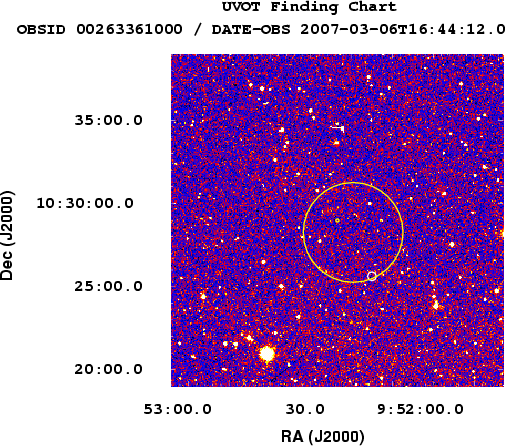
TITLE: GCN/SWIFT NOTICE
NOTICE_DATE: Tue 06 Mar 07 16:47:23 UT
NOTICE_TYPE: Swift-UVOT Image
TRIGGER_NUM: 263361, Seg_Num: 0
POINT_RA: 148.041d {+09h 52m 10s} (J2000)
POINT_DEC: +10.496d {+10d 29' 47"} (J2000)
ROLL: 283.112d
IMG_START_DATE: 14165 TJD; 65 DOY; 07/03/06
IMG_START_TIME: 60250.16 SOD {16:44:10.16} UT, 162.0 [sec] since BAT Trigger Time
FILTER: 10, White
EXPOSURE_ID: 194892251
X_OFFSET: 420 [pixels]
Y_OFFSET: 1065 [pixels]
WIDTH: 160 [pixels]
HEIGHT: 160 [pixels]
X_GRB_POS: 580
Y_GRB_POS: 1225
BINNING_INDEX: 1
IM_URL: sw00263361000msuni0161.fits
SUN_POSTN: 346.86d {+23h 07m 27s} -5.63d {-05d 37' 34"}
SUN_DIST: 160.84 [deg] Sun_angle= -10.7 [hr] (East of Sun)
MOON_POSTN: 193.14d {+12h 52m 34s} -8.51d {-08d 30' 48"}
MOON_DIST: 48.64 [deg]
MOON_ILLUM: 93 [%]
GAL_COORDS: 225.61, 44.73 [deg] galactic lon,lat of the pointing direction
ECL_COORDS: 146.60, -2.29 [deg] ecliptic lon,lat of the pointing direction
COMMENTS: SWIFT-UVOT Image.
COMMENTS: The GRB Position came from the XRT Position Command.
COMMENTS: The image has 2x2 binning (compression).
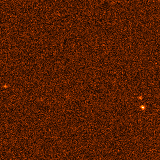
TITLE: GCN/SWIFT NOTICE
NOTICE_DATE: Tue 06 Mar 07 16:47:41 UT
NOTICE_TYPE: Swift-UVOT Processed Image
TRIGGER_NUM: 263361, Seg_Num: 0
POINT_RA: 148.041d {+09h 52m 10s} (J2000)
POINT_DEC: +10.496d {+10d 29' 47"} (J2000)
ROLL: 283.112d
IMG_START_DATE: 14165 TJD; 65 DOY; 07/03/06
IMG_START_TIME: 60250.16 SOD {16:44:10.16} UT, 162.0 [sec] since BAT Trigger Time
FILTER: 10, White
EXPOSURE_ID: 194892251
X_OFFSET: 420 [pixels]
Y_OFFSET: 1065 [pixels]
WIDTH: 160 [pixels]
HEIGHT: 160 [pixels]
X_GRB_POS: 580
Y_GRB_POS: 1225
BINNING_INDEX: 1
IM_URL: sw00263361000msuni0161.fits
SUN_POSTN: 346.86d {+23h 07m 27s} -5.63d {-05d 37' 34"}
SUN_DIST: 160.84 [deg] Sun_angle= -10.7 [hr] (East of Sun)
MOON_POSTN: 193.14d {+12h 52m 34s} -8.51d {-08d 30' 52"}
MOON_DIST: 48.65 [deg]
MOON_ILLUM: 93 [%]
GAL_COORDS: 225.61, 44.73 [deg] galactic lon,lat of the pointing direction
ECL_COORDS: 146.60, -2.29 [deg] ecliptic lon,lat of the pointing direction
COMMENTS: SWIFT-UVOT Processed Image.
COMMENTS: The GRB Position came from the XRT Position Command.
COMMENTS: The image has 2x2 binning (compression).
COMMENTS: All 4 attachments are included.
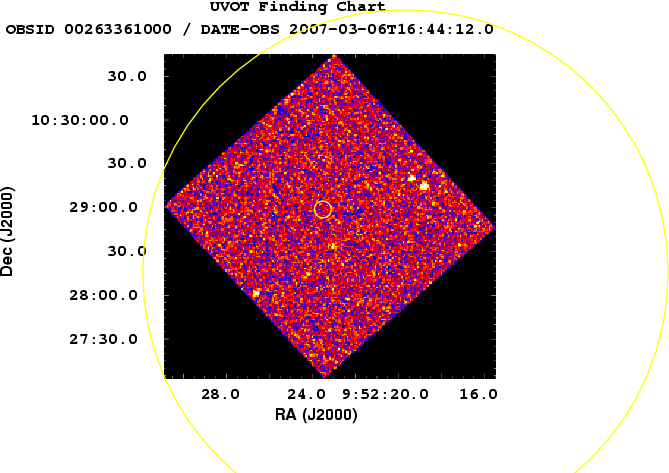
TITLE: GCN/SWIFT NOTICE
NOTICE_DATE: Tue 06 Mar 07 16:52:51 UT
NOTICE_TYPE: Swift-UVOT Source List
TRIGGER_NUM: 263361, Seg_Num: 0
POINT_RA: 148.041d {+09h 52m 10s} (J2000)
POINT_DEC: +10.498d {+10d 29' 52"} (J2000)
POINT_ROLL: 283.114d
IMG_START_DATE: 14165 TJD; 65 DOY; 07/03/06
IMG_START_TIME: 60355.52 SOD {16:45:55.52} UT, 267.3 [sec] since BAT Trigger Time
FILTER: 3, V
BKG_MEAN: 1.719
N_STARS: 16
X_OFFSET: 100 [pixels]
Y_OFFSET: 745 [pixels]
X_MAX: 1059 [pixels]
Y_MAX: 1704 [pixels]
DET_THRESH: 11
PHOTO_THRESH: 5
SL_URL: sw00263361000msufc0267.fits
SUN_POSTN: 346.87d {+23h 07m 28s} -5.62d {-05d 37' 29"}
SUN_DIST: 160.84 [deg] Sun_angle= -10.7 [hr] (East of Sun)
MOON_POSTN: 193.18d {+12h 52m 44s} -8.53d {-08d 32' 03"}
MOON_DIST: 48.69 [deg]
MOON_ILLUM: 93 [%]
GAL_COORDS: 225.61, 44.73 [deg] galactic lon,lat of the pointing direction
ECL_COORDS: 146.60, -2.28 [deg] ecliptic lon,lat of the pointing direction
COMMENTS: SWIFT-UVOT Source List.
TITLE: GCN/SWIFT NOTICE
NOTICE_DATE: Tue 06 Mar 07 16:53:11 UT
NOTICE_TYPE: Swift-UVOT Processed Source List
TRIGGER_NUM: 263361, Seg_Num: 0
POINT_RA: 148.041d {+09h 52m 10s} (J2000)
POINT_DEC: +10.498d {+10d 29' 52"} (J2000)
POINT_ROLL: 283.114d
IMG_START_DATE: 14165 TJD; 65 DOY; 07/03/06
IMG_START_TIME: 60355.52 SOD {16:45:55.52} UT, 267.3 [sec] since BAT Trigger Time
FILTER: 3, V
BKG_MEAN: 1.719
N_STARS: 16
X_OFFSET: 100 [pixels]
Y_OFFSET: 745 [pixels]
X_MAX: 1059 [pixels]
Y_MAX: 1704 [pixels]
DET_THRESH: 11
PHOTO_THRESH: 5
SL_URL: sw00263361000msufc0267.fits
SUN_POSTN: 346.87d {+23h 07m 28s} -5.62d {-05d 37' 28"}
SUN_DIST: 160.84 [deg] Sun_angle= -10.7 [hr] (East of Sun)
MOON_POSTN: 193.18d {+12h 52m 44s} -8.54d {-08d 32' 07"}
MOON_DIST: 48.69 [deg]
MOON_ILLUM: 93 [%]
GAL_COORDS: 225.61, 44.73 [deg] galactic lon,lat of the pointing direction
ECL_COORDS: 146.60, -2.28 [deg] ecliptic lon,lat of the pointing direction
COMMENTS: SWIFT-UVOT Processed Source List.
COMMENTS: All 4 attachments are included.
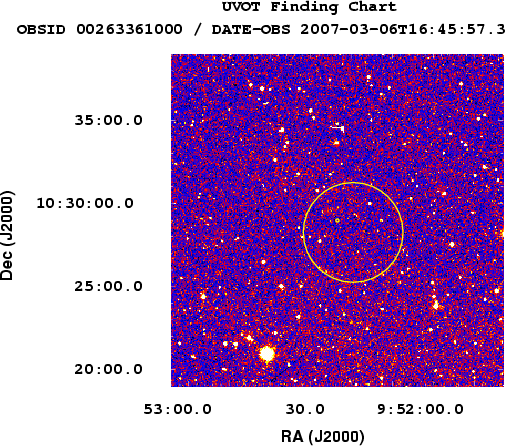
TITLE: GCN/SWIFT NOTICE
NOTICE_DATE: Tue 06 Mar 07 16:54:11 UT
NOTICE_TYPE: Swift-UVOT Image
TRIGGER_NUM: 263361, Seg_Num: 0
POINT_RA: 148.041d {+09h 52m 10s} (J2000)
POINT_DEC: +10.498d {+10d 29' 52"} (J2000)
ROLL: 283.114d
IMG_START_DATE: 14165 TJD; 65 DOY; 07/03/06
IMG_START_TIME: 60355.52 SOD {16:45:55.52} UT, 267.3 [sec] since BAT Trigger Time
FILTER: 3, V
EXPOSURE_ID: 194892357
X_OFFSET: 420 [pixels]
Y_OFFSET: 1065 [pixels]
WIDTH: 160 [pixels]
HEIGHT: 160 [pixels]
X_GRB_POS: 580
Y_GRB_POS: 1225
BINNING_INDEX: 1
IM_URL: sw00263361000msuni0267.fits
SUN_POSTN: 346.87d {+23h 07m 28s} -5.62d {-05d 37' 27"}
SUN_DIST: 160.84 [deg] Sun_angle= -10.7 [hr] (East of Sun)
MOON_POSTN: 193.19d {+12h 52m 46s} -8.54d {-08d 32' 21"}
MOON_DIST: 48.70 [deg]
MOON_ILLUM: 93 [%]
GAL_COORDS: 225.61, 44.73 [deg] galactic lon,lat of the pointing direction
ECL_COORDS: 146.60, -2.28 [deg] ecliptic lon,lat of the pointing direction
COMMENTS: SWIFT-UVOT Image.
COMMENTS: The GRB Position came from the XRT Position Command.
COMMENTS: The image has 2x2 binning (compression).
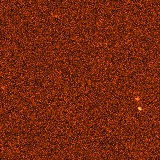
TITLE: GCN/SWIFT NOTICE
NOTICE_DATE: Tue 06 Mar 07 16:54:27 UT
NOTICE_TYPE: Swift-UVOT Processed Image
TRIGGER_NUM: 263361, Seg_Num: 0
POINT_RA: 148.041d {+09h 52m 10s} (J2000)
POINT_DEC: +10.498d {+10d 29' 52"} (J2000)
ROLL: 283.114d
IMG_START_DATE: 14165 TJD; 65 DOY; 07/03/06
IMG_START_TIME: 60355.52 SOD {16:45:55.52} UT, 267.3 [sec] since BAT Trigger Time
FILTER: 3, V
EXPOSURE_ID: 194892357
X_OFFSET: 420 [pixels]
Y_OFFSET: 1065 [pixels]
WIDTH: 160 [pixels]
HEIGHT: 160 [pixels]
X_GRB_POS: 580
Y_GRB_POS: 1225
BINNING_INDEX: 1
IM_URL: sw00263361000msuni0267.fits
SUN_POSTN: 346.87d {+23h 07m 28s} -5.62d {-05d 37' 27"}
SUN_DIST: 160.84 [deg] Sun_angle= -10.7 [hr] (East of Sun)
MOON_POSTN: 193.19d {+12h 52m 46s} -8.54d {-08d 32' 24"}
MOON_DIST: 48.70 [deg]
MOON_ILLUM: 93 [%]
GAL_COORDS: 225.61, 44.73 [deg] galactic lon,lat of the pointing direction
ECL_COORDS: 146.60, -2.28 [deg] ecliptic lon,lat of the pointing direction
COMMENTS: SWIFT-UVOT Processed Image.
COMMENTS: The GRB Position came from the XRT Position Command.
COMMENTS: The image has 2x2 binning (compression).
COMMENTS: All 4 attachments are included.
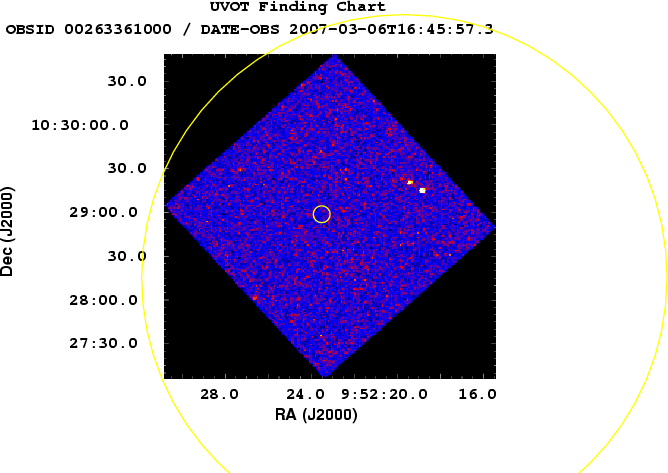
RA(J2000) = 09h 52m 20s Dec(J2000) = +10d 28' 17"with an uncertainty of 3 arcmin (radius, 90% containment, including systematic uncertainty). We did not receive a BAT lightcurve down TDRSS so we can not say anything about its shape. However, this 12 second trigger does have a strong image significance, and as such, the reliability is high.
RA(J2000) = 09h 52m 23.5s Dec(J2000) = 10d 28' 57.7"with an uncertainty of 6.1 arcseconds (radius, 90% containment). This location is 71 arcseconds from the BAT on-board position, within the BAT error circle. The initial flux in the 0.1s image was 1.3e-08 erg/cm2/s (0.2-10 keV).
UT Limit mag Exp. Time Mar. 6.71383 Rc > 20.3 123 * 10 Mar. 6.71378 J > 17.3 120 * 10 Mar. 6.71363 Ks > 15.1 96 * 10
RA(J2000) = 09 52 23.39 Dec(J2000) = +10 28 55.3with an estimated error radius of 3.6 arcsec (90% confidence). This lies 67 arcsec and 3.3 arcsec from the onboard BAT and XRT positions given in GCN Circ. 6169, respectively.
RA(J2000) = 09h 52m 23.3s Dec(J2000) = 10d 28' 37.2"with an uncertainty of 2.4 arcmin, (radius, sys+stat, 90% containment). The partial coding was 28%.
RA: 09:52:23.31 (J2000) DEC: +10:28:55.26 (J2000)with errors of 0.3" in each coordinate.
----------------------------------------- StartUT Filter Limit Exposure ========================================= 16:52:28 Ic 17.3 60s x 7 16:48:28 J 13.3 20s x 121 =========================================
Wh_find 162 262 98 19.8 V 267 11158 1259 20.5 B 745 6257 403 21.5 U 721 6053 413 21.0 W1 697 5848 236 19.0 M2 673 5633 236 18.7 W2 773 6651 397 19.5 Wh 162 6462 512 20.7These upper limits are not corrected for the small Galactic extinction, corresponding to a reddening of E(B-V)=0.03 (Schlegel et al. 1998), towards the direction of this burst.
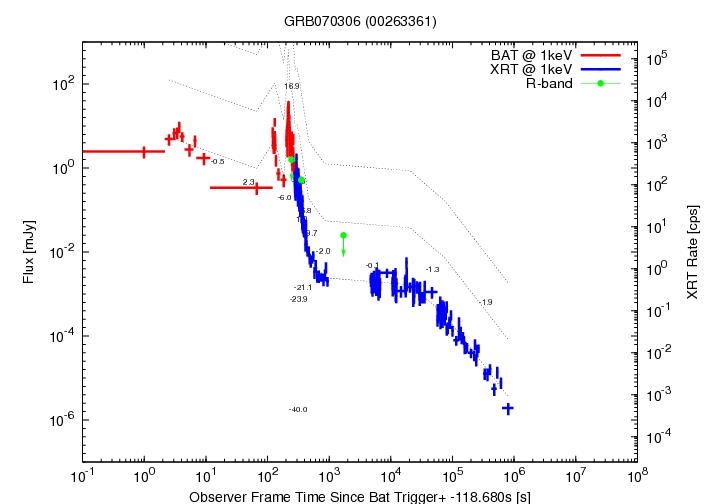
-------------------------------------------------------------- Start(UT) End(UT) Num. of frames Limit (mag.) -------------------------------------------------------------- 16:43:36 16:44:06 1 ~15.8 16:45:24 16:59:40 9 ~17.0 ---------------------------------------------------------------